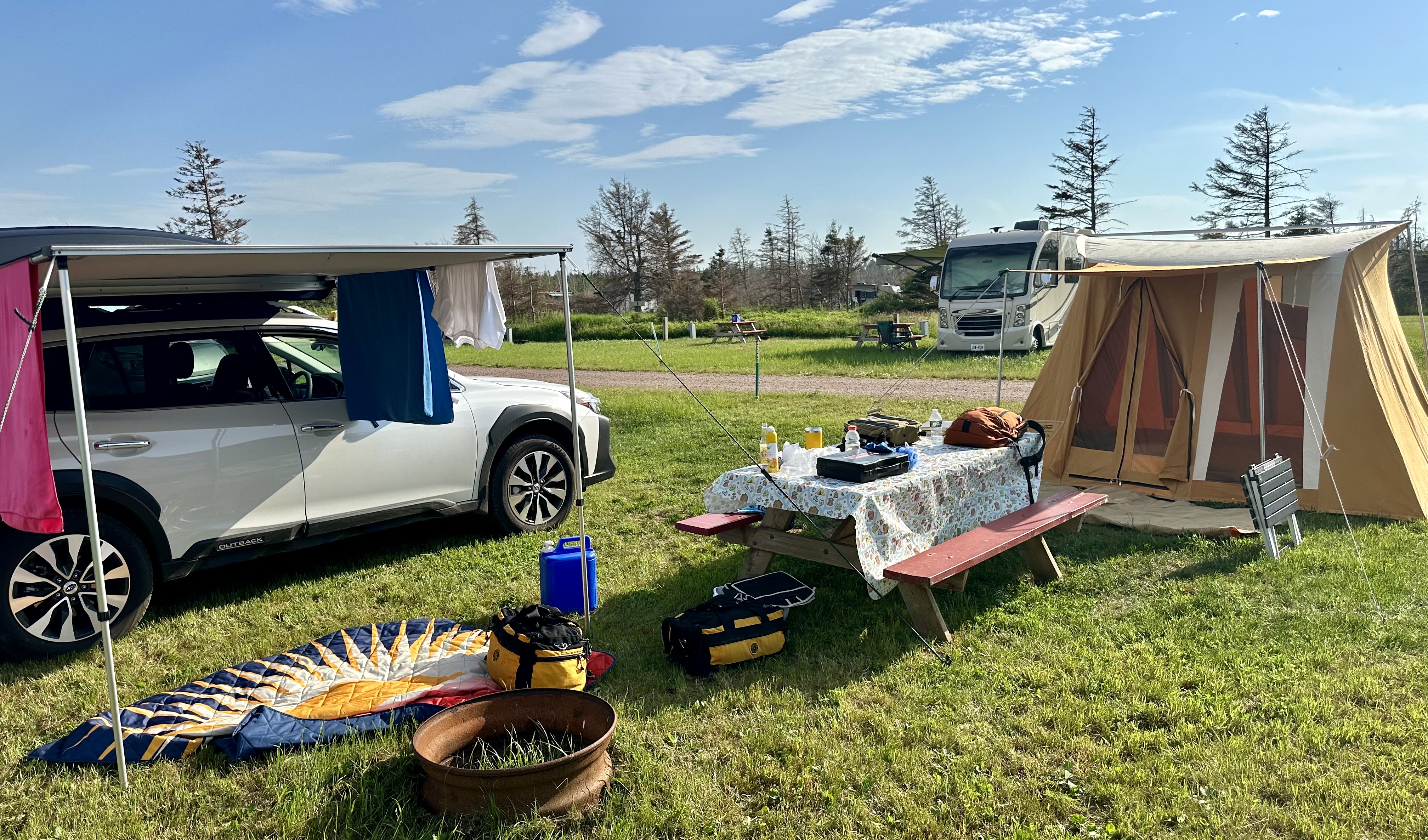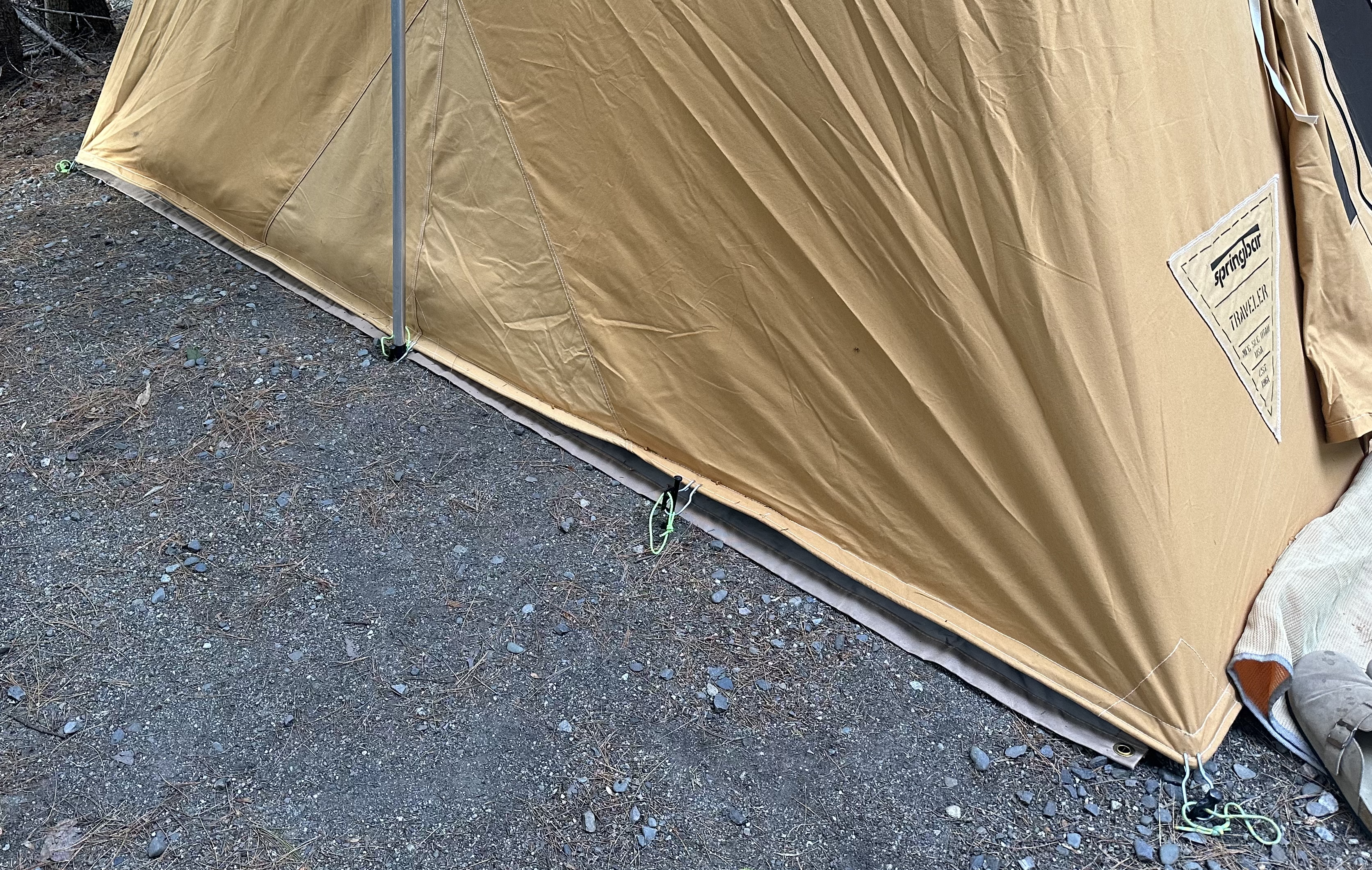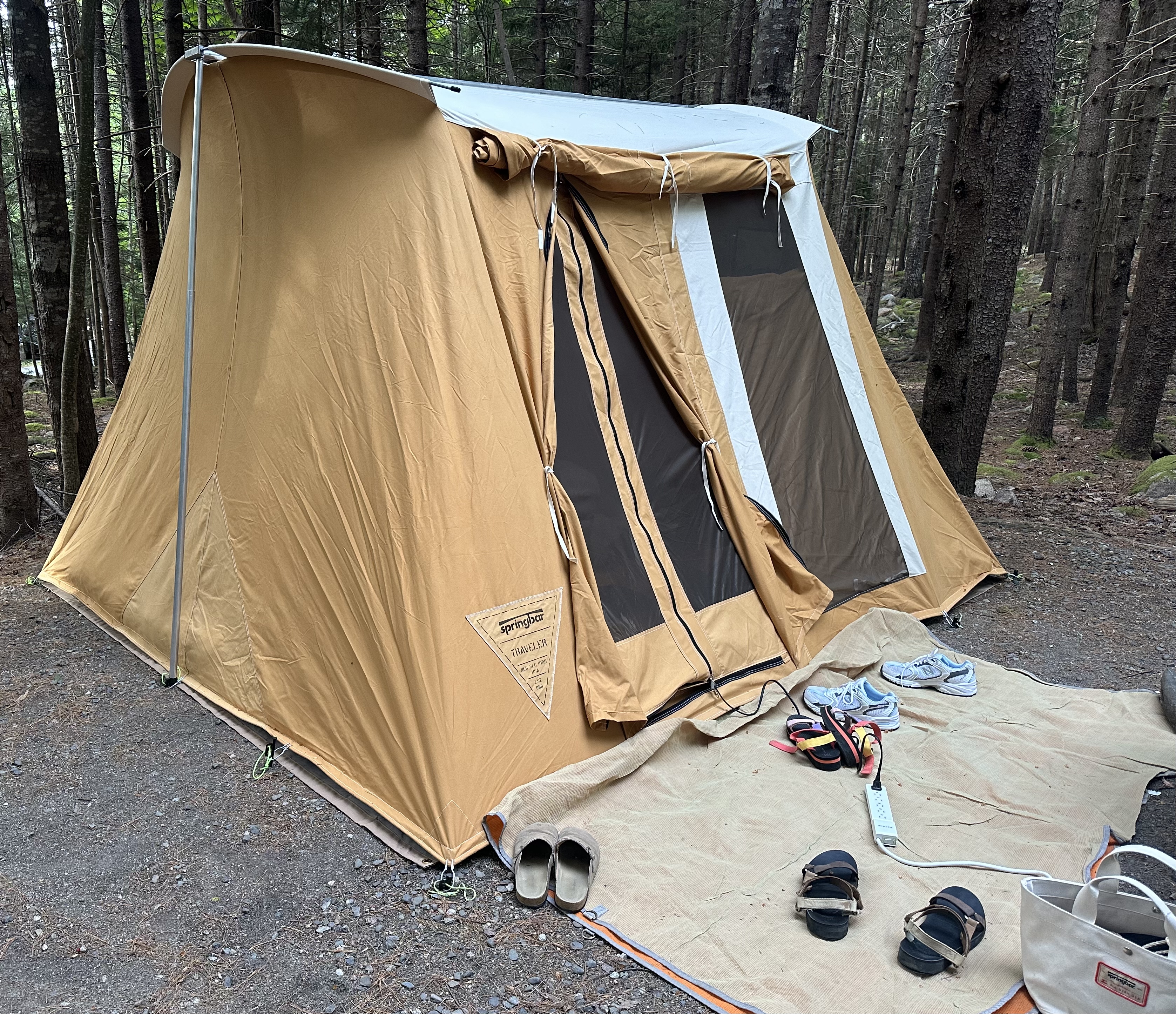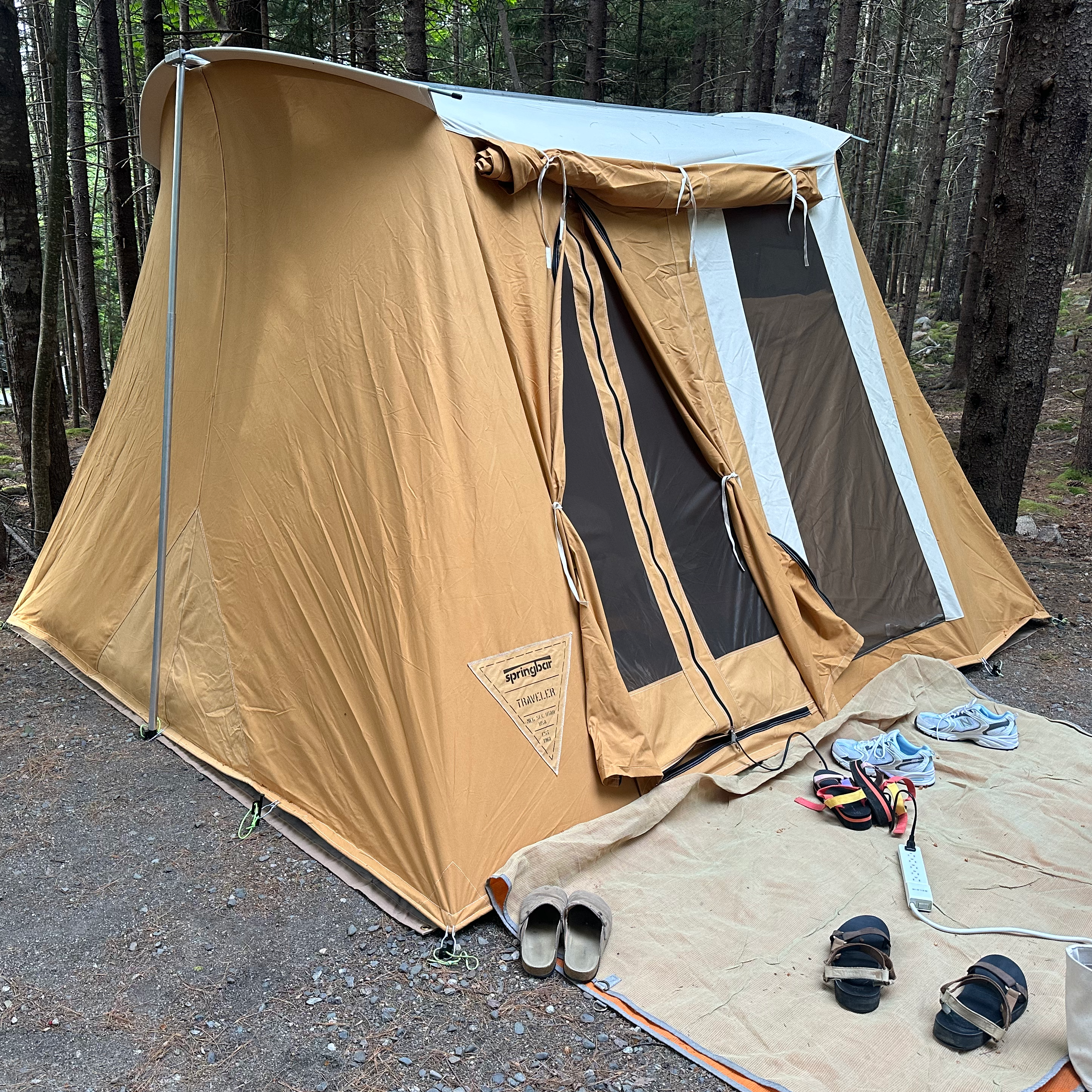
So I bought a spring bar tent. This is one of those big heavy canvas tents. I’d been looking around for reviews, and everything seemed just a little over positive if you know what I mean so I thought I’d do one myself.
I bought the Traveler. It is made in the USA, and is 10 feet square. I bought one because our old plastic tent, a Gazelle T8, was very noisy as we found out in a pretty vicious storm in the Badlands last year. That same storm took the tent out, ripped off the fly. It’s not a very good design. Um, and the tent? Very. It collapsed the tent as well.

In all fairness, we didn’t have all of the guidelines out which would have stablized the tent but wouldn’t have helped the fly stay on.
I was looking for something quieter and with a lot more wind resistance and more stability and didn’t need any guidelines or rain flies. It always seems like we don’t put that stuff up and then that’s when the rain comes and that’s when the wind comes.
The Traveler has one door and window in the front and two windows in the back. It weighs about 70 pounds with the tent and the poles, and the steaks. I think it doesn’t really matter when you get that heavy, because it’s all in separate bags, and each one of them is still kind of heavy. If you’re expecting younger kids to help set it up, they will struggle. Everything is heavy or requires a fair amount of force to put in place. Teenagers do fine.
I used the tent on a trip to Canada. My wife and my three daughters, age 15 to 19, and I hopped into a couple cars and we drove up to, Nova Scotia and Prince Edward Island for a two week road trip. We camped most of the time. We had some rain in the middle, and we stayed no more than two nights in a single spot. So not really the best use case for a very heavy tent that takes a lot of stakes, but it actually worked out pretty well. So my first impressions of this tent are that it’s well, it’s heavy. It’s really heavy. Um, when you’re used to, you know, a let’s say an REI kingdom six that comes in it maybe 30 pounds this is really quite heavy. It’s big. The tent bag is 27″ by 15″ the pole bag is 56″ long, and there is a canvas tote with the stakes and a few other items.
It fit in my wife’s Wrangler and my Outback just fine, and in the my rooftop box. It’s not too big to fit the car. On the ground it’s even bigger. 10 feet square, and the interior height is high enough that having the accessory organizer was a stretch for me at 5’6″.
It’s very stable. This tent is not blowing away. Like I said, it’s pretty heavy. And it has about 22 stakes that hold it down. So there’s a lot of stakes that need to be driven. The stakes that come with it are 12 inches long, and they’re bent metal and they’re probably really great at average dirt. I replaced them with straight nail type stakes that I bought off of Amazon, mainly just because I wanted to put cord loops on them to aid in pulling them out and also to clip them on to a carabiner to keep them organized. The stakes I bought worked fine. The stakes they supplied probably would have worked fine. Although some of the sites we were in had crushed rock and you need a very sharp, strong stake to pound into that. I think next time I’m just going to go buy lag bolts, which seems to be the new trend and using an impact driver and like a 8 to 12 inch lag bolt, I think that is the cat’s meow and that is what I’m going to look at using. It’s just a little bit of an investment, you know, like 100 bucks, because screws that big are not particularly cheap and it means getting an impact driver and carrying that around along with the charger. And I’d probably still end up carrying the hammer and the stakes as a backup.
The Traveler is made in the USA so how about that made in USA quality? Well, it turns out my tent was missing a steak loop. They were happy to send me one that I will install at some point. I didn’t miss having it while we were camping around and hadn’t noticed it during my test setup at home.

The whole tent is just very sturdy. If you’re used to backpacking tents, this is just super heavy duty. The ropes that they supplied to guy out the porch roof, a flap of fabric that goes over the front door & window, is quarter inch thick rope. There’s a very large tensioner on each rope. That’s really nice to work with when you’re used to working with paracord which is thin and hard to grab and it’s kind of a pain to be tying taughtline hitches all the time. So having this big, wooden tensioner and this thick rope is really nice, actually.
Yeah, the tent smells. The girls were not too fond of that. I didn’t really even notice, but, yeah, it smells like canvas. It didn’t smell like mildew.
I thought the flat porch roof was pretty stupid when I looked a the tent online. I figured it would fill up with water with any rain, so what’s the point? Well the shad it provides is handy, and it kept the dew off everything under it. It was also easier than I expected to pitch it one way or the other to shed rain, so it worked well.
There are zippers on both sides of it, like half of a zipper, really. You can buy portico panels that zip to the sides and I actually kind of wish we bought those because, well, it took me a long time to learn this, but half of your tent is the tent. The other half is the vestibule. When you have a place that isn’t clean to put all the stuff that you want protected from the weather somewhat, but you don’t really want it in the tent like wet jackets and boots. You don’t really want that stuff outside getting wet if it rains, but you don’t want it in the tent either. That’s what the vestibule is for. And likewise, when you’re getting ready in the morning and you’re putting on your shoes, you don’t want to do that in the tent. The portico panels would have provided more protection. On the other hand, we weren’t anywhere long enough to really appreciate them.
The floor is super thick, it’s pretty heavy duty. But I would not put cots in this tent without something under the legs. The material is thick but not super abrasion resistant. I’ve already got a mark from the tent being dragged into final position and there must have been a sharp rock. I don’t think I would be putting furniture in this tent, of any kind, without something underneath the legs. They sell patches for the floor. They say you can send the tent back to have it repaired. I have no idea how that could possibly be cost effective because mailing it would probably be $100, but then again the tent is 10x that so maybe.
So what about when it gets wet? That’s the big concern everybody has with a canvas tent. “Oh, my God. If it gets wet, you’re screwed!” No, not really. We had some rain, and it was the night before we were driving to Halifax. We were in campsite on Cape Breton Island. We came back from dinner to go to bed and it started drizzle. We got everything packed up as well as we could and it drizzled all night long. No leaks, and we hadn’t seasoned the tent. My daughter said at one point she had a few drops on her, but nobody was complaining. We didn’t have the “touch the inside of the tent that leaks” phenomena that people always talk about with canvas tents. Really the inside just felt very stiff, hard and cold. It was noticeably humid, but it would be in a plastic tent as well.

You do need to pitch the porch roof to keep the water from running off. But like I said, that wasn’t very hard to do. It worked out fine. The only problem is, well, this canvas, when it gets wet, it gets stiff, it gets heavy, and it gets stiiiifffff. It’s almost like cardboard. Where before you could kind of like tug one corner or another to get it to flatten out while you were preparing to fold it & roll it up, this took a lot more effort and it was really I don’t think we would have been able to roll it up tight enough to get into the original bag. We just rolled it up loosely and stuffed into the car top box because I didn’t really want it inside the car at that point. There it stayed for quite a while because we were driving to Halifax.
So we, we broke camp in the morning, we scampered around and packed up all this wet gear and got to stuff in the in the cars. Drove to Halifax and we were staying in a hotel in Halifax. So nothing came out of the car except for our luggage for that night. And then the next day we drove to another campsite in Nova Scotia that was actually a few hours away and we got there in the evening. We set up the tent and we wiped the floor with a microfiber cloth to dry it Yeah, it smelled like a wet tent, but the night spent soaking wet in a car top box didn’t cause any issues.
We ended up spending only one night at that site, and while the tent had dried a bit it wasn’t fully dry so we packed it up and headed home. It was more nights before we would get home so I laid it out for a while the following evening in the hotel parking lot, in some sun. That dried it out quite a lot. Enough that I didn’t really worry about it.
So back to Kentucky we went and then I unrolled the thing in my living room. I didn’t set it up, I just unrolled it. And in a house with air conditioning, it had dried the rest of the way overnight. It was no problem. Once it was dry, it went back to its nice limp self and we could fold it up compactly and get it back in the bag all right.
What’s not so great? Well, it’s not self-supporting, right? So if you find yourself on, you know, in the middle of a parking lot, well, either you got stakes that you can pound into a parking lot or you’re not having a tent. I think there’s a way to make this work with a frame that the poles would sit on and the stake loops would connect to, but nobody wants to haul that much stuff.
I bought the rain fly for it. Uh, mainly because again, having had a bad storm last year, I was wanted to be prepared. I brought it with me and never took it out of the box. But I think if, if you were stuck in this tent for days and it was wet, you would want the rain fly because covers the windows and it would let you open the windows a little bit for ventilation.
I’m happy I bought it. It’s heavy. It’s, it’s an investment in time and effort and money. But it’s sturdy and it’s confidence inspiring and it’s pretty comfy. Um, so yes, I’m happy with it. I think it it’s best if you can live at one spot for a while. Taking it down and setting it up every day would get old really fast. You would really want to use the leg screws.
It’s maybe not a great hot weather tent because it has windows on only two sides. But on the other hand, hot weather, at least in the eastern half of the US, tends to come with rain showers and thunderstorms. You can close the windows & door from the inside, which is not always the case with plastic tents. You don’t have to worry about running out to put a fly on or putting up guy wires. Honestly, I wish we bought it sooner.
The only regret I have is that they offer factory seconds at a discount. They don’t always have every model and whatnot, but based on the one I got that was missing a stake loop, which is a bigger flaw than any of the seconds mentioned, I should have just bought a factory second saved myself some money.
So there you go. Is it an only tent? You know, I think it could be.
If you’re thinking about buying one of these, I hope this helps you decide. I can’t tell you whether it’s the right choice for you, but I believe it’s been the right choice for us. Have a great day!

Leave a Reply